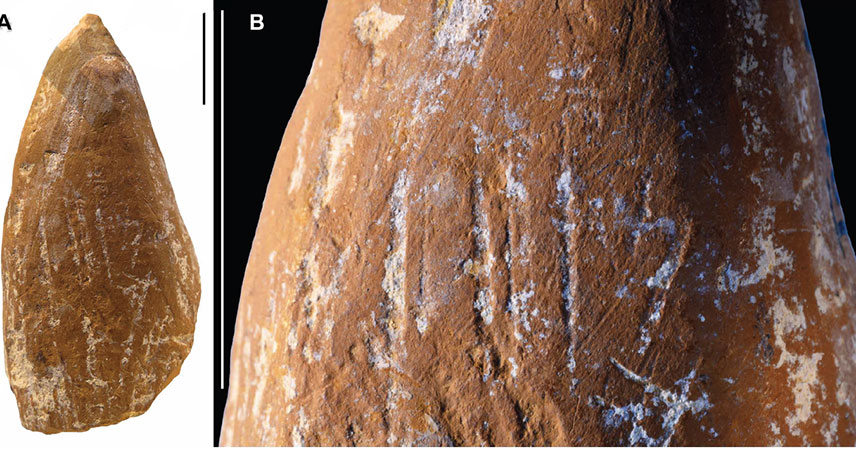A groundbreaking study has recently unveiled a fascinating truth about Neanderthals. Two pieces of ocher, discovered in ancient Ukrainian rock shelters, were not merely natural pigments. Instead, they served as Neanderthal crayons. This remarkable discovery dates back 47,000 to 46,000 years ago. It significantly reshapes our understanding of these ancient hominins.
These artifacts show clear signs of deliberate shaping. They were also resharpened over time, much like modern drawing tools. An additional ocher piece bore carefully carved parallel lines. These findings provide compelling evidence. They suggest Neanderthals possessed an artistic streak and engaged in symbolic behavior.
The Groundbreaking Discovery: Neanderthals as Artists 🎨
The notion of Neanderthals as crude, unthinking brutes is rapidly fading. New archaeological evidence consistently challenges this outdated stereotype. The recent finds from Ukraine are particularly illuminating. They offer a direct glimpse into the sophisticated cognitive abilities of our ancient relatives.
Researchers meticulously examined two distinct ocher chunks. These pieces were unearthed from the Zaskalnaya V site. They exhibited wear patterns consistent with sustained use as drawing implements. Their edges were intentionally blunted and then sharpened again. This indicates a purposeful and repeated application of the material.
Furthermore, a third ocher fragment presented intricate parallel incisions. This carving is not accidental. It strongly suggests a deliberate act of marking or decoration. Such actions point towards symbolic thought and a capacity for abstract expression. These are traits once thought exclusive to early modern humans.
These ancient crayons aren’t just curiosities. They are powerful indicators. They reveal a deeper complexity in Neanderthal culture. Their ability to shape tools for specific, non-utilitarian purposes like drawing is profound. It forces a re-evaluation of their intellectual and cultural lives.
Beyond Pigment: The Multifaceted World of Ocher ⛏️
Ocher, an iron-rich mineral, was a highly valuable resource for ancient hominins. Its uses were incredibly diverse. It served as a powerful pigment for coloring objects and bodies. Ocher was also crucial for tanning animal hides, making them more pliable. It could be mixed with resins to create strong adhesives for hafting tools.
Beyond practical applications, ocher also had medicinal properties. It acted as an insect repellent. It could even prevent infections. Neanderthals extracted this versatile material in various ways. They might knap flakes from hard nodules. Or they could carve softer pieces directly. The resulting powder was then used for many purposes.
Most ocher finds in archaeological sites are ambiguous. Their wear patterns can fit multiple uses. However, the Ukrainian “crayons” are different. Their unique shaping and resharpening marks them as specialized tools. They were specifically designed for applying pigment, likely for artistic or symbolic reasons.
Advanced scientific techniques were vital to this discovery. Researchers employed X-ray fluorescence and scanning electron microscopes. These tools allowed for detailed analysis of the ocher chunks. They revealed microscopic wear patterns. This confirmed the intentional modification and use of these artifacts as crayons. This scientific rigor strengthens the conclusions drawn by the researchers.
Zaskalnaya V: A Window into Neanderthal Ingenuity 💡
The rock shelters near Bilohirsk in Crimea are archaeologically significant. Neanderthals occupied these sites for tens of thousands of years. They lived there between 100,000 and 33,000 years ago. These shelters have yielded dozens of ocher pieces. Many show general signs of pigment extraction.
However, the finds from Zaskalnaya V stand out. This specific site is where the two crayon-like artifacts were discovered. Their presence here is not random. It suggests a particular context or activity. This site might have been a hub for such symbolic practices.
The concentration of uniquely modified ocher at Zaskalnaya V is compelling. It implies a sustained engagement with these materials. It wasn’t a one-off experiment. Instead, it points to a developed cultural practice. Neanderthals at this site were actively shaping and using ocher for purposes beyond mere utility.
Understanding the specific context of Zaskalnaya V is crucial. It helps us interpret the broader implications. This site offers a unique window. It shows us how Neanderthals interacted with their environment. More importantly, it reveals how they expressed themselves within their communities. These artifacts are silent witnesses to a rich, complex past.
Redefining Our Ancient Cousins: Cognitive Implications and Cultural Depth 🧠
The discovery of Neanderthal crayons fundamentally alters our perception of these ancient humans. It provides strong evidence of their advanced cognitive abilities. The deliberate shaping, resharpening, and carving of ocher pieces require foresight. They demand planning and fine motor skills. These are not traits of a primitive species.
This evidence supports the growing consensus. Neanderthals were not simply survivors. They were thinkers. They engaged in complex behaviors. Their use of ocher for symbolic purposes suggests an inner world. They likely possessed a capacity for abstract thought. This challenges the long-held view of Homo sapiens’ unique intellectual superiority.
The implications extend to their cultural depth. Did they use these crayons for body decoration? Were they marking objects or cave walls? Perhaps they were for communication within their groups. Whatever the specific application, it signifies a move beyond basic subsistence. It points towards cultural practices and shared symbolic meanings. This discovery helps bridge the perceived cognitive gap. It brings Neanderthals closer to early modern humans. It suggests that many behaviors, including artistic expression, developed earlier than previously thought. Or perhaps, these capacities evolved independently in different hominin lineages. This makes the story of human evolution even richer and more complex.
Key Insights: The Ocher Revolution 🌟
- Neanderthals possessed symbolic capabilities and an artistic streak, as evidenced by deliberately shaped and resharpened ocher crayons.
- The findings from Zaskalnaya V, Ukraine, highlight a sophisticated and purposeful engagement with ocher beyond mere utilitarian applications.
- Advanced scientific techniques, like X-ray fluorescence and scanning electron microscopy, are crucial for uncovering the nuanced behaviors of ancient hominins.
- This discovery profoundly redefines our understanding of Neanderthal cognition and cultural depth, challenging outdated stereotypes and emphasizing their complex inner lives.
- The presence of such artistic tools suggests a shared capacity for creativity and abstract thought among different human lineages, enriching the narrative of human evolution.
Source: Wear marks suggest Neanderthals made ocher crayons



